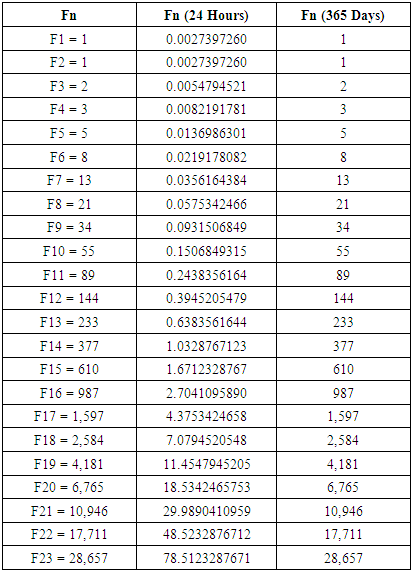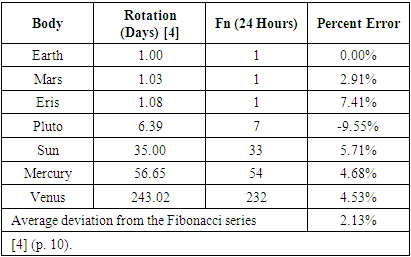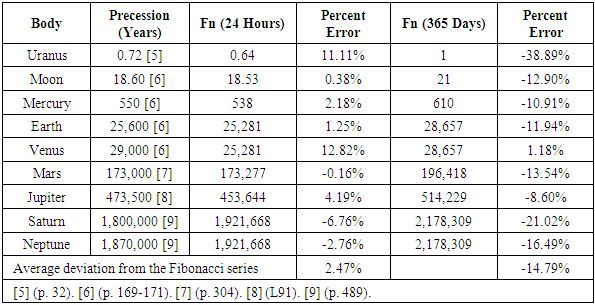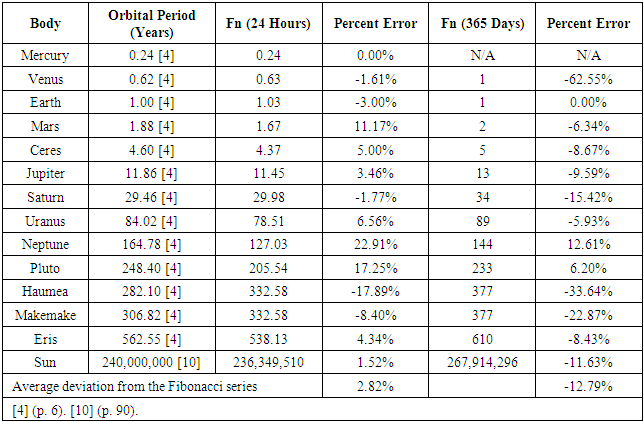-
Paper Information
- Paper Submission
-
Journal Information
- About This Journal
- Editorial Board
- Current Issue
- Archive
- Author Guidelines
- Contact Us
International Journal of Astronomy
p-ISSN: 2169-8848 e-ISSN: 2169-8856
2019; 8(1): 8-12
doi:10.5923/j.astronomy.20190801.02

Modeling Celestial Mechanics Using the Fibonacci Numbers
Robert G. Sacco
Fibonacci Lifechart, Toronto, Canada
Correspondence to: Robert G. Sacco, Fibonacci Lifechart, Toronto, Canada.
| Email: |  |
Copyright © 2019 The Author(s). Published by Scientific & Academic Publishing.
This work is licensed under the Creative Commons Attribution International License (CC BY).
http://creativecommons.org/licenses/by/4.0/

The purpose of this study was to model the relationship between celestial mechanical cycles and the Fibonacci numbers. Data were collected on known celestial mechanical cycles including the period of rotation, precession, and orbit. The data were then compared to two time scaling methods for the Fibonacci numbers based on 24-hour and 365-day units of time. Results showed a significant correlation between celestial mechanics and Fibonacci numbers measured in 24-hour periods with an average deviation of less than 3%. No statistically significant correlation was found between celestial mechanics and Fibonacci numbers measured in 365-day periods. These results will be useful for understanding the optimal way the solar system achieves its stability.
Keywords: Rotating bodies, Orbital mechanics, Precession, Fibonacci series, Golden ratio, Models, Periodicity
Cite this paper: Robert G. Sacco, Modeling Celestial Mechanics Using the Fibonacci Numbers, International Journal of Astronomy, Vol. 8 No. 1, 2019, pp. 8-12. doi: 10.5923/j.astronomy.20190801.02.
Article Outline
1. Introduction
- There is now considerable evidence that the motion of the different celestial bodies is not random [1, 2]. In particular, research has found that celestial bodies are attuned to gravitational resonances involving the Fibonacci numbers [2]. Current practice has been to use a ratio unit as the basis for comparing celestial resonance periods. Yet, the sinusoidal component parameters of celestial bodies may also refer to a certain time unit of the Fibonacci numbers. Such a time unit approach may provide a new method to investigate the hierarchical stability of the solar system. Thus, in this study, a time-unit approach was used to investigate the correlation of Fibonacci numbers and celestial mechanical cycles including the period of rotation, precession, and orbit. The Fibonacci series was measured in 24-hour and 365-day units of time. It was hypothesized that celestial mechanical cycles would be associated with the Fibonacci numbers expressed in 24 hours because of the unique self-organizing properties enabled by 24-hour periodicity.
2. Method
2.1. Data Analysis
- Data were collected on known celestial mechanical cycles. The cycles included rotation period, precession period, and the orbital period. Correspondence between celestial mechanical cycles and Fibonacci numbers was assessed by subtracting the celestial cycle value from the Fibonacci number to obtain a deviation percentage. Fibonacci numbers were chosen for comparison on the basis that they were the closest in proximity to the celestial mechanical cycle. The differences in the average deviation values were analyzed for commensurability. Conventionally, a 5% rejection region is taken to indicate statistical significance [3]. Thus, in the analysis, this was used as the cut-off for significance. That is, if a data set falls within 5% of the actual value of the Fibonacci series on either side (plus or minus), the data is close enough to the actual value that it can be treated as statistically significant. On the other hand, if the average deviation is outside this limit, then such differences can be accounted for by random error.
2.2. Measurements and Calculations
- The Fibonacci series may essentially be expressed in two units of time: the 24-hour daily rotation of the earth and 365-day orbit around the sun (see Table 1). In the first method of measurement (Table 1, Column 2), each Fibonacci number is divided by 365, since in one day, the Earth travels about 1/365 of the way around the sun. For example, the first Fibonacci number (Column 2, Row 2) expressed in a 24 hour unit of time is approximately 1/365. This produces a constant accrual rate with the interesting properties of the Lucas numbers and the powers of Phi. The Lucas numbers are in the following integer sequence: 2, 1, 3, 4, 7, 11, 18, 29, 47, 76, 123, etc. The Lucas numbers use the same recurrence relation as the Fibonacci numbers but with initial values 2 and 1 instead of 0 and 1. Similarly, the powers of Phi approach the values of the Lucas numbers: Phi1 = 1.6180, Phi2 = 2.6180, Phi3 = 4.2361, Phi4 = 6.8541, Phi5 = 11.0902, Phi6 = 17.9443, Phi7 = 29.0345, Phi8 = 46.9787, Phi9 = 76.0132, etc.
|
3. Results
3.1. Rotation Period
- The rotational period of a celestial object is the time taken for it to complete one rotation around its own axis relative to the background stars. The analysis examined the rotation period for the Sun, Planets, and Dwarf Planets. Only rotation periods greater than one day were examined. Statistical analysis was not able to be performed with the Fibonacci numbers expressed in 365 days for lack of sufficient whole number comparison. A table detailing the correspondences between the rotation period and the key study variables is shown in Table 2 (Note: adding all Fibonacci numbers expressed in 24-hours produces a pattern of numbers—1, 2, 4, 7, 12, 20—that are each one number off from the Fibonacci numbers). In line with predictions, the average deviation was statistically related to Fibonacci numbers expressed in 24 hours (2.13%). Thus, Fibonacci numbers expressed in a 24 hour unit of time successfully predicted rotation period.
|
3.2. Precession Period
- Next, it was tested whether Fibonacci time cycles predicted precession of the planets and moon. Precession is the slow change in the orientation of a planet due to gravitational torques exerted by other solar system bodies in which the tip of the axis rotates (precesses) just as a spinning top does. The Sun also has precession, but it is exceedingly small because of the Sun’s nearly spherical shape, fast rotation rate, and limited gravitational torque from other bodies. A table detailing the correspondences between precession and the key study variables is shown in Table 3. In line with predictions, the average deviation was statistically related to Fibonacci numbers expressed in 24 hours (2.47%), and not statistically related to Fibonacci numbers expressed in 365 days (-14.79%). Thus, Fibonacci numbers expressed in a 24 hour unit of time successfully predicted precession.
|
3.3. Orbital Period
- Finally, it was tested whether Fibonacci time cycles predicted orbital periods of the Sun, Planets, and Dwarf Planets. The orbital period is the time a given astronomical object takes to complete one orbit around another object. It applies to planets orbiting the Sun, and the Sun orbiting the galaxy. A table detailing the correspondences between the orbital period and the key study variables is shown in Table 4. In line with predictions, the average deviation was statistically related to Fibonacci numbers expressed in 24 hours (2.82%), and not statistically related to Fibonacci numbers expressed in 365 days (-12.79). Thus, Fibonacci numbers expressed in a 24 hour unit of time successfully predicted the orbital period.
|
4. Discussion
- The present results show that the Fibonacci resonances in celestial mechanics are more than ratio-based. The Fibonacci series expressed in 24 hour-based units was associated with several celestial cycles. Specifically, the Fibonacci series expressed in 24 hour-based units predicted the period of rotation, precession, and orbit across multiple time scales. Perhaps as important, it was found that the Fibonacci series in year-based units did not predict celestial mechanics. It seems that a critical consequence of the Fibonacci series is that it entrains celestial dynamics based on a 24-hour periodicity and not a 365-day periodicity. This, in turn, contributes to the stability of the solar system.This data provides an explanation for why rotation and orbital resonances are linked to ratios in accordance with the Fibonacci series [2]. That is, the harmonic ratios observed are explained by hierarchical entrainment of oscillations in keeping with the Fibonacci series expressed in a 24 hour unit of time. Mathematically, it could be argued that the significance of the number 24 may be due, at least in part, to the 24 repeating digits of the Fibonacci series [11]. Not only do the 24 repeating digits of the Fibonacci series themselves approximate a sine wave [11], but just as a sine wave has alternating positive and negative phases, so too the Fibonacci series has alternating positive and negative phases. This is further evidence suggesting that the Fibonacci series corresponds to a sine wave.The alternating positive and negative phases of the Fibonacci series are indicated by taking the ratio of every adjacent number in the series (see Table 5). Table 5 shows how the ratios of the successive numbers in the Fibonacci series quickly converge on the golden ratio (0.618…). Notice that as we continue down the sequence there is an alternating bigger (+) and smaller (-) pattern. For example, the ratio 2 divided by 3 is 0.666 (+), and 3 divided by 5 is 0.60 (-). The basic Fibonacci sine wave pattern has implications that might extend to quantum mechanics and the observable properties of a system. To draw such a conclusion or indication for quantum mechanics, it may be noted that the golden ratio and Fibonacci numbers appear in quantum mechanics [12-14].
|
5. Conclusions
- Gravitation is thought to be responsible for the cohesion of our planetary system and a critical organizing principle of matter. Gravitational resonance implies that specific harmonic configurations are repeated. According to the present findings the Fibonacci series expressed in a unit period of 24 hours, and not a unit period of 365 days, was significantly correlated to celestial mechanical cycles. These considerations hold for the period of rotation, precession, and orbit. Thus the conclusion is that the hierarchical stability of the solar system is related to the Fibonacci series expressed in a unit period of 24 hours. Ultimately, these results can help to provide a deeper theoretical understanding of the mechanisms of resonance and long-term stability in the solar system.
 Abstract
Abstract Reference
Reference Full-Text PDF
Full-Text PDF Full-text HTML
Full-text HTML



